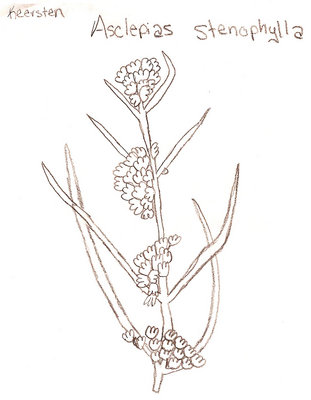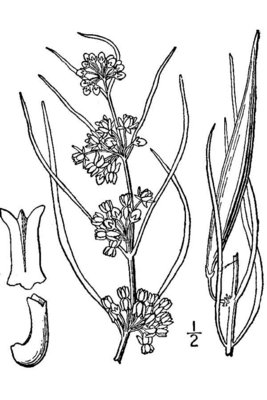 Portfolio: Medicinal Plants of the Sicangu Lakota
Portfolio: Medicinal Plants of the Sicangu Lakota
Investigation
Asclepias stenophylla also known as Narrowleaved Milkweed by Keersten
1sagebrush11

Asclepias stenophylla. © 2008 1sagebrush11
Lakota Name: Tiŋsila Pejủta (means prairie turnip medicine)
 Listen to Lakota Plant Name: Tiŋsila Pejủta
Listen to Lakota Plant Name: Tiŋsila Pejủta
Scientific Name: Asclepias stenophylla
Common Name: Narrowleaved milkweed
Medicinal uses: The root is given to children when they have no appetite. Tiŋsila means wild turnip, and Pejủta means medicine from grass roots.
The narrowleaved milkweed is a popular plant, but it is becoming endangered in certain parts of the country. In Illinois, Iowa, and Minnesota the plant is endangered (USDA Plants Database).
Description: The plant is up to 80 cm high rising from a thick, woody, root. The narrowleaved milkweed is a perennial with a few erect and usually unbranched stems that are decumbent or upright. Foliage of the milkweed is moderately to sparsely hairy, and the sap is milky. The flowers are less than 0.5 inches long, have five oblong, pale green reflexed segments and five white hoods. The hoods have a 3-lobed tip. The middle lobe is triangular and shorter than the two lateral lobes. The fruits are in pods 4 to 5 inches long, erect on a downward-curved pedicel; many seeded.

Click on an image to view larger version & data in a new window

Asclepias stenophylla. Courtesy of Kentucky Native Plant Society
Distribution: Asclepias stenophylla grows in Arkansas, Colorado, Iowa, Arkansas, Illinois, Kansas, Louisiana, Minnesota, Missouri, Montana, Nebraska, Oklahoma, South Dakota, Texas, and Wyoming. The narrowleaved milkweed occurs sporadically throughout the black hills. Existing or potential threats are habitats being taken away from them, and people picking them by mistake (USDA Plants Database).
Information on the Internet
References
Rogers, Dilwyn J. 1980. Lakota Names and Traditional Uses of Native Pants by Sicangu (Brule) People in the Rosebud Area, South Dakota. The Rosebud Educational Society, St. Francis, S. D.
Learning Information
- ToL Learner Level:
- Target Grade/Age Level:
- All Grade/Age levels.
- Can be modified for many age/grade levels
- Type of Activity
- Classroom resource; Field Trip resource; Web-based resource; Informal learning resource
- Science Subject / Key Words
- Taxonomy;
- Morphology & Anatomy
- Curricular Areas:
- Language:
- Teaching and Learning Strategy:
- Visual Instruction;
- Discussion;
- Lecture;
- Presentation
- Comments
- This is my first time, and I tried my best.
Education Standards
State Education Standards
- South Dakota Education Standards
- 9-12.L.1.1. Students are able to relate cellular functions and processes to specialized structures within cells.
- 9-12.L.1.2. Students are able to classify organisms using characteristics and evolutionary relationships of major taxa.
- 9-12.S.1.1. Students are able to explain ethical roles and responsibilities of scientists and scientific research.
- 9-12.S.1.2. Students are able to evaluate and describe the impact of scientific discoveries on historical events and social, economic, and ethical issues.
- 9-12.N.1.1. Students are able to evaluate a scientific discovery to determine and describe how societal, cultural, and personal beliefs influence scientific investigations and interpretations.
- 9-12.N.2.1. Students are able to apply science process skills to design and conduct student investigations. (Synthesis)
- 9-12.N.2.2. Students are able to practice safe and effective laboratory techniques.
National Education Standards
- National Education Standards
CONTENT STANDARD A: As a result of activities in grades 9-12, all students should develop
- Abilities necessary to do scientific inquiry
- Understandings about scientific inquiry
CONTENT STANDARD B: As a result of their activities in grades 9-12, all students should develop an understanding of
- Structure of atoms
- Structure and properties of matter
- Chemical reactions
- Motions and forces
- Conservation of energy and increase in disorder
- Interactions of energy and matter
CONTENT STANDARD C: As a result of their activities in grades 9-12, all students should develop understanding of
- The cell
- Molecular basis of heredity
- Biological evolution
- Interdependence of organisms
- Matter, energy, and organization in living systems
- Behavior of organisms
CONTENT STANDARD E: As a result of activities in grades 9-12, all students should develop
- Abilities of technological design
- Understandings about science and technology
CONTENT STANDARD F: As a result of activities in grades 9-12, all students should develop understanding of
- Personal and community health
- Population growth
- Natural resources
- Environmental quality
- Natural and human-induced hazards
- Science and technology in local, national, and global challenges
CONTENT STANDARD G: As a result of activities in grades 9-12, all students should develop understanding of
- Science as a human endeavor
- Nature of scientific knowledge
- Historical perspectives
About This Page
Author: 1sagebrush11
Classroom Project: Medicinal Plants of the Lakota Sioux
Lead-Deadwood High School
Lead, South Dakota United States
License: Creative Commons Attribution-NonCommercial License - Version 3.0
Correspondence regarding this page should be directed to , Lead-Deadwood High School
Page copyright © 2008 1sagebrush11
 Treehouses are authored by students, teachers, science enthusiasts, or professional scientists. Anyone can sign up as a treehouse contributor and share their knowledge and enthusiasm about organisms. Treehouse contributions are checked for general accuracy and quality by teachers and ToL editors, but they are not usually reviewed by expert scientists. If you spot an error, please get in touch with the author or the teacher. For more information about quality control of Tree of Life content, see Status of Tree of Life Pages.
Treehouses are authored by students, teachers, science enthusiasts, or professional scientists. Anyone can sign up as a treehouse contributor and share their knowledge and enthusiasm about organisms. Treehouse contributions are checked for general accuracy and quality by teachers and ToL editors, but they are not usually reviewed by expert scientists. If you spot an error, please get in touch with the author or the teacher. For more information about quality control of Tree of Life content, see Status of Tree of Life Pages.
About This Portfolio
I would like to acknowledge the following individuals for their help with this project:
- Rev. Raymond Bucko S.J., Creighton University Department of Sociology and Anthropology
- My student mentor Devan, Kim Loeffen, Tony Beisiot, Wade Mackey, and Sharon Burns for their technical help.
- F.J. Doody, Buechel Memorial Museum, St. Francis, S.D.
- Ben Black Bear Jr. for his audio of Lakota names, St. Francis, S.D. (Author of the Introduction of Dilwyn Rogers' Book of Father Buechel's research.)
- Katja Schulz Managing Editor ToL
- And mostly, my students for their perserverence!
Robin Cochran-Dirksen

Lead-Deadwood High School
Correspondence regarding this page should be directed to Robin Cochran-Dirksen at
Page copyright © 2008 Robin Cochran-Dirksen
 Listen to Lakota Plant Name: Tiŋsila Pejủta
Listen to Lakota Plant Name: Tiŋsila Pejủta






 Go to quick links
Go to quick search
Go to navigation for this section of the ToL site
Go to detailed links for the ToL site
Go to quick links
Go to quick search
Go to navigation for this section of the ToL site
Go to detailed links for the ToL site